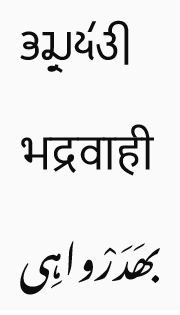
The Indo-Aryan languages are a branch of the Indo-Iranian languages in the Indo-European language family. As of the early 21st century, they have more than 800 million speakers, primarily concentrated east of the Indus river in Bangladesh, India, Pakistan, Sri Lanka, Maldives and Nepal. Moreover, apart from the Indian subcontinent, large immigrant and expatriate Indo-Aryan–speaking communities live in Northwestern Europe, Western Asia, North America, the Caribbean, Southeast Africa, Polynesia and Australia, along with several million speakers of Romani languages primarily concentrated in Southeastern Europe. There are over 200 known Indo-Aryan languages.

Pakistan is a multilingual country with over 70 languages spoken as first languages. The majority of Pakistan's languages belong to the Indo-Iranian group of the Indo-European language family.

Kashmiri or Koshur is a Dardic Indo-Aryan language spoken by around 7 million Kashmiris of the Kashmir region, primarily in the Kashmir Valley of the Indian-administrated union territory of Jammu and Kashmir, over half the population of that territory. Kashmiri has split ergativity and the unusual verb-second word order.

The Northern Indo-Aryan languages, also known as Pahāṛi languages, are a proposed group of Indo-Aryan languages spoken in the lower ranges of the Himalayas, from Nepal in the east, through the Indian states of Jammu and Kashmir, Uttarakhand, Himachal Pradesh and Punjab was coined by G. A. Grierson.

Pahari-Pothwari is an Indo-Aryan language variety of Lahnda group, spoken on the Pothohar Plateau in the far north of Punjab, Pakistan, as well as in most of Pakistan-administered Azad Kashmir and in western areas of Indian-administered Jammu and Kashmir, is known by a variety of names, the most common of which are Pahari, and Pothwari.

The Hindi Belt, also known as the Hindi Heartland, is a linguistic region encompassing parts of northern, central, eastern, and western India where various Northern, Central, Eastern and Western Indo-Aryan languages are spoken, which in a broader sense is termed as Hindi languages, with Standard Hindi serving as the lingua franca of the region.
The Western Pahari languages are a group of Northern Indo-Aryan languages spoken in Northern India, primarily in the state of Himachal Pradesh and Jammu.

Kangri is an Indo-Aryan language spoken in northern India, predominantly in the Kangra, Una and Hamirpur of Himachal Pradesh as well as in some parts of Mandi and Chamba districts of Himachal Pradesh and Gurdaspur, Rupnagar and Hoshiarpur districts of Punjab. Kangri language is also spoken in Duggar i.e. Jammu region and in a few villages of Pakistan by the people belonging to the families migrated from Kangra Valley. It is associated with the people of the Kangra Valley. The total number of speakers has been estimated at 1.1 million as of 2011.

Lahnda, also known as Lahndi or Western Punjabi, is a group of north-western Indo-Aryan language varieties spoken in parts of Pakistan and India. It is defined in the ISO 639 standard as a "macrolanguage" or as a "series of dialects" by other authors. Its validity as a genetic grouping is not certain. The terms "Lahnda" and "Western Punjabi" are exonyms employed by linguists, and are not used by the speakers themselves.
The phoneme inventory of the Marathi language is similar to that of many other Indo-Aryan languages. An IPA chart of all contrastive sounds in Marathi is provided below.

Mandeali is an Indo-Aryan language spoken in northern India, predominantly in the Mandi district of Himachal Pradesh by the people of the Mandi Valley and particularly in the major city of Mandi. Other spellings for the name are Mandiyali and Mandiali. UNESCO reports it is one of the highly endangered languages of India. Speakers of the dialect have decreased by 21% from 1961 to 2001.
Pahari, or Pahadi is an ambiguous term that has been used for a variety of languages, dialects and language groups, most of which are found in the lower Himalayas.

The Punjabi dialects and languages or Greater Punjabi are a series of dialects and languages spoken around the Punjab region of Pakistan and India with varying degrees of official recognition. They have sometimes been referred to as the Greater Punjabi macrolanguage. Punjabi may also be considered as a pluricentric language with more than one standard variety.

Bilaspuri, or Kahluri (Takri:𑚊𑚩𑚥𑚱𑚤𑚯) is a language spoken in northern India, predominantly in the Bilaspur district of Himachal Pradesh. It is associated with the people of the former princely state of Bilaspur in the Panjab Hills.

Sarazi or Sirazi is an Indo-Aryan language spoken in the Saraz region of the Jammu division of Jammu and Kashmir, India. It is native to the Saraz region, a hilly area taking up the northern half of Doda district and parts of neighbouring Ramban and Kishtwar districts. Sarazi is spoken as a first language by 46,000 people, primarily Hindus, but it is also used as a lingua franca of the Saraz region and so is also spoken as a second language by Muslims, whom are native speakers of Kashmiri.

Chambeali is a Western Pahari language spoken in the Chamba district of Himachal Pradesh.

Pangwali is a Western Pahari language of Himachal Pradesh, India. It is spoken in the Pangi Tehsil of Chamba district, and is threatened to go extinct. Pangwali is natively written in the Takri script, but Devanagari is used as well. It is very similar to the Padderi language of Padder, J&K.

Gaddi is an Indo-Aryan language of India. It is spoken by the Gaddi people primarily residing in the Bharmour region of Chamba district and the upper reaches of Kangra district in Himachal Pradesh. It is also spoken in neighbouring parts of Jammu, with Gaddi villages found in Udhampur, Kathua and Doda districts.
Khāṣi (खाषी) is an Indo-Aryan dialect of Jammu and Kashmir, India. It belongs to the Western Pahari group and is spoken in some of the mountainous areas north of Jammu. It is different from the north-eastern Himalayan dialects of Assam and Meghalya, belonging to the Mon-Khmer Family.
Bhaderwahi people are an Indo-Aryan ethnolinguistic group native to the Bhaderwah Valley in the Doda district of Jammu and Kashmir, India, who traditionally speak the Bhadarwahi language.















